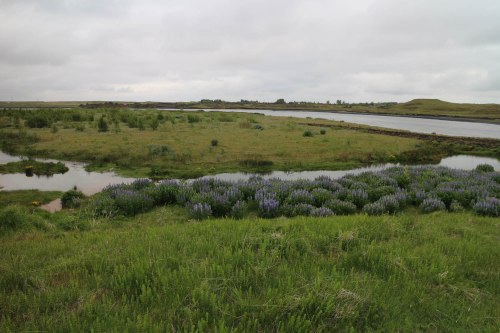Kirkjubæjarklaustur (Klaustur) is a village in the south of Iceland on the hringvegur (road no. 1 or Ring Road) between Vík í Mýrdal and Höfn. It is part of the municipality of Skaftárhreppur and has about 500 inhabitants.
Even before the time of the first Norse settlement in Iceland, Irish monks are thought to have lived here. Since 1186, a well known convent of Benedictine nuns, Kirkjubæjar Abbey, was located in Kirkjubæjarklaustur, until the Reformation in 1550. The names of the waterfall Systrafoss („waterfall of the sisters“) and of the lake Systravatn („water of the sisters“) on the highland above the village refer to this abbey. Folk tales illustrate the history with stories about good and sinful nuns. The Systrastapi (sister’s rock) is where two of the convent’s nuns were buried after being burned at the stake. One of the nuns was accused of selling her soul to the Devil, carrying Communion bread outside the church, and having carnal knowledge with men; the other was charged with speaking blasphemously of the Pope. After the Reformation, the second sister was vindicated, and flowers are said to bloom on her grave, but not that of the first nun. Systravatn also has a legend relating to the convent. The nuns traditionally bathed in the lake, and one day two nuns saw a hand with a gold ring extending from the water. When they tried to seize the ring, they were dragged below the water and drowned.
The village became well known in Iceland during the Lakagígar volcano eruptions in 1783. The pastor of the local church and dean of Vestur-Skaftafellssýsla, Jón Steingrímsson (is) (1728 – 1791), delivered what became known as the „Fire Sermon“ (eldmessu) on July 20, 1783. The legend says that this sermon stopped the lava flow, and the village was spared at the last moment. The current church, constructed in 1974, was built in memory of the Reverend Jón Steingrímsson.
Today, the village is an important service center for the farms in the region as well as for tourists and weekend visitors. (Wikipedia)
During summer time many bird species are nesting close to the village and the river Skaftá which flows beside the village. Arctic Terns have a big colony almost in the middle of the village, so many other migrant birds are nesting there too.
The recording was captured early morning 7th of June 2016 and is a part of 7 hours long recording
Many bird species are in this recording, Arctic tern, Red wing, Common Snipe, Whimbrel, Common Redshank, Red-necked Phalarope and probably many other species. What I love most in this recording is in the middle of the recording, is a „special song“ of Eurasian Wigeon which is not a common bird in my recordings.
Quality headphones are recommended while listening at low to mid level, or in speakers at low level. Be careful, sometimes the level goes high when birds fly by.
(mp3, 265kbps / 59Mb)
Recorder: Sound devices 788
Mics: Sennheiser MKH20
Pic: Canon EOS-M
Location: 63.787049, -18.050793
Weather: Cloudy, Calm, around 7 °C
